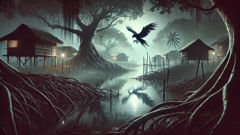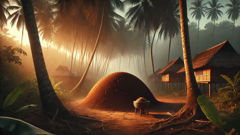Introduction
On the southern shores of a great island the sea sings against black volcanic sand and the wind is always a messenger. Villages cluster among palms and mangroves; fishermen mend nets beneath outriggers and elders tell the stories that keep a people steady. Among these tales, one rises above the rest: the saga of two brothers, Indarapatra and Sulayman, born to a lineage of hunters and keepers of the land, who would come to be remembered whenever storms broke or children asked why the mountains shadow the sea. This retelling reaches back to a time when the world felt larger and more mutable, when islands could still be reshaped by monsters and the courage of a few brave souls. Indarapatra, the elder brother, moved with quiet precision: a mind like water steadying itself to the shape of the boat, a patience taught by tides. Sulayman, younger and quick as a reed in wind, carried fire in his laugh and a fierce loyalty that refused to bow. Together, they were not simply warriors; they were bearers of an old promise—a promise that the island’s laughter would not be stolen, that mothers would sleep without fearing thunder, that children could run barefoot in the river. The monsters came from places where light does not linger: from the deep tides, the high ridges, the smoldering marshes, and the winds above. Each carried a hunger that was more than appetite: a hunger for fear, for ruin, for dominion. What follows is a richly woven account of their trials—strange landscapes and stranger beasts, cunning that outwitted brute force, songs that became spells, allies who appeared in unexpected forms, and the fathomless loyalty between brothers that proved the island’s greatest weapon. Read this not only as a chronicle of battles but as a living map of a people’s world: how fear is named, how courage grows, how a community remembers itself. It is an invitation to step into the hot, sweet air of Mindanao, to listen for the hush before dawn when the island sighs and says the names of its protectors. This introduction opens the way for the long telling that follows: the origins of the monsters, the brothers' journeys, their cunning and sacrifices, and the legacy that lingers in every coconut tree bent by wind. The story is old and new at once—anchored in place, alive in every telling.
The Rising Terrors: Monsters of Sea and Mountain
Long before lanterns were made of glass, when villages still used woven baskets as bowls and the sky felt nearer, the island was a place of balance and barter. People took what they needed and left offerings where the sea met the land: a fragrant coil of tobacco, a bowl of rice, a woven bracelet laid upon stone. Such small rituals kept the world ordered, or so the elders taught. But balance can fray. It begins with small ruptures—unfinished offerings, a monk's old song misremembered, a river turned muddy by erosion—and then a nameless thing smells opportunity and comes. The first of the monsters arrived not as a roar but as a hush that fell over the fishers' nets. Boats returned with nets shredded and fish vanishing from the deepest traps. Night after night, songs of the sea were swallowed by a sound like a distant grinding. People blamed the weather, blamed careless nets; they could not name the thing that made the water itch with unease.

Indarapatra watched from the rocks. He knew the tides and the patterns of currents; he had memorized the topography of the shoals and the migrations of the moon-pull. His brother Sulayman ran barefoot over the reef, testing the exposed sandbars, speaking to children who still believed crab shells were talismans. The brothers felt the island change like a fever in a child: its skin hot, its breath short. When the first monster rose, the sea did not make a throne for it but a grave. Its head was huge as a house, and its eyes were like lanterns sunk into tar. Its body wound and flowed like a black river over coral; fins were knife-blades. It called itself by no name a human tongue could catch. The fishermen said it was a wak-wak of the open water, others whispered it must be a diwata turned jealous. Indarapatra and Sulayman believed the island had been breached.
They tracked the creature through a month of tides. The pattern was cunning: the beast took only certain fish, left others, and shaped its path to appear easily seen then vanish. Villagers left fires on the shoreline, left gifts in hopes of calming whatever spirit had been offended. Those offerings were taken and mutilated—rice scattered, tobacco soaked, bracelets untied and strewn—an insult that signaled malice. Indarapatra knew one thing with the clarity of star navigation: you cannot beat a thing by brute force alone. Monsters, like storms, read weakness. The elder devised a plan of deception; Sulayman prepared traps, quick lines and sharp stakes hidden beneath the shallow reef.
The first battle was as much craft as clash. Under moonlight, the brothers and a handful of brave villagers worked together. They filled old gourds with fermented sap that smelled of rotting fruit, and they wove nets that rattled when the tides moved. When the monster came, its appetite betrayed it: it struck the bait-laden net and brought its head close enough for Sulayman to plunge a barbed spear into a soft underscale. The beast’s cry split the night. Yet the victory was hollow; the wound revealed that this creature was but a herald. When its blood touched the water, a new stench rose, and far across the mountain ridges, another alarm clanged: the land began to tremble.
From the high ridges came the second monster: a hulking, stone-skinned titan born from the green bones of the island. Unlike the water-born creature, this one moved like a slow avalanche, vegetation rippling as if it were a living cloak. Its voice was the cracking of old trees. It had eyes of molten rock and teeth like shards of basalt. The forests shook when it walked. Shadows fled under its steps and small animals hid themselves in hollows. Farmers awoke to fields trodden flat and streams diverted from their course. The elders had names for such things—giants that had slept too long, ancient yokai of the land—but naming did not unmake their destructiveness.
The brothers realized the monsters were not acting independently. The island's fabric had frayed and their challenge demanded more than weapons; it required knowledge. Indarapatra studied the patterns of the earthquake-steps: the titan favored paths that had once been old riverbeds. Sulayman listened to the wind and discerned from the birds which side the giant favored. They summoned allies—hunters who knew the gullies, weavers who could hide men in reed-snares, and a woman elder who had once been a paddler to distant reefs. From her they learned a song, old and half-remembered, that talked not to beasts but to the places beasts claimed. Songs, in this telling, were spells of belonging. When you sang the island's true name—layer upon layer of local names woven into one—you reminded even stone and sea why they belonged to each other.
The battle with the mountain titan was a study in exhaustion. The men lured it into a narrow gorge where its bulk could not find purchase. They used fire to soften the outer crust of the monster's hide and wells of oily sap to slow it. Indarapatra bored a long spear tipped with sharpened coral and caged within the metal-fluided heart of a volcanic stone. Sulayman ran like a wind among its ankles, driving supports and tightening ropes around its legs until the giant stumbled into a bed of reed snares. The final stroke was never a simple strike; it was a coordinated weaving of cunning: the giant, struggling, became trapped and then, with more pity than triumph, Indarapatra spoke a name the elders had whispered, and the song the woman elder taught lifted like smoke and settled over the titan. Its rage eased. The mountain creature did not die so much as it remembered, through a fog of pain, that it had once stood as guardian and not as predator. It retreated into the ribs of the island, slow as a tide, leaving a scarred trail and a new humility in the hearts of the villagers.
But the island's wounds ran deeper. While the brothers dealt with the sea and mountain, other unnatural things stirred. From the marshes, where steam rose and the earth hummed with buried rot, came a third monster, a thing that breathed sickness. Its shape was a twilight of limbs and eyes, a shifting tessellation of mud and reeds. It slithered into the canals, poisoning wells and making crops blight as it passed. Out of the high winds came the fourth, a creature of air and thunder that could pluck roofs from houses and tear the sails of boats as if they were leaves. The brothers now faced not two beasts but a quartet of terrors interconnected like a storm's teeth: sea, stone, marsh, and wind. The island's survival hinged on their ability to stitch together the knowledge of salt-sailors, mountain-keepers, swamp-walkers, and the elders who read the weather by the birds. They were learning, as every true hero must, that heroism is never solitary: it is an accumulation of small, steady efforts from many hands.
As the first great cycle of fighting closed, the villagers settled into a fragile calm. Nets mended. The titan's footsteps became rumors rather than immediate threat. But the marsh's sickness ran quietly, and the winds still remembered the thunder-beast's laugh. Indarapatra and Sulayman retreated for a time to a small cove where the reef made a shallow amphitheater. There, beneath a sky roiled with distant storms, they planned, ate fish dried over salt, and listened to the island speak in small things: the squeal of a crab, the way a certain vine wound toward the light. The long fight ahead demanded more than spear and song; it demanded a map made of relationships—between human and earth, between speech and silence, between the boldness of a brother's leap and the tempered patience of an elder's counsel. They would need to corral allies, to use the island as both shield and argument, and to accept that some sacrifices would be required. But in the echo of lullabies and the hush of prayers left on stones, they found the resolve to continue.
The Brothers' Trials and the Final Battle
The second arc of the brothers' struggle grew out of necessity, as most decisive turns do. After the first victories and near-misses, Indarapatra and Sulayman realized the monsters were not chaotic acts of nature but symptoms of an older wound in the island's living body. Human neglect and a forgotten promise had given them footholds. The marsh that bore the third monster had been drained and rerouted by careless clearing; the winds above were richer for a loneliness that sprang from abandoned kinship with high places. To fight them, the brothers had to become whole-systems healers, to mend where the island had been torn, to thread the old names back into daily practice.

Their first task was to learn the marsh's patterns. They walked with the women who had once considered the swamp their pantry, who knew the sound of frogs in different months, who could tell when roots would hold and when the ground would take. The marsh monster—a thing of fetid breath and many mouths—moved like a rumor: it ate quietly, spread its rot, and left behind creatures maddened by thirst. Indarapatra recognized a weakness not of body but of diet. The beast fed on waste and neglect; it abhorred certain herbs and the smoke of particular resins. The villagers, guided by the women, prepared bundles of those herbs and strewed them in channels. They reopened old freshwater streams and dug shallow basins that let the marsh breathe. Sulayman, with a small band, drove the monster into these new currents by lighting fires that turned away its favored smells. There was a day when the marsh stank so badly the brothers thought they would be swallowed by the air itself; at dusk something huge and mucous slid from the reeds and writhed among the newly opened channels. The men did not strike it at once. Instead, they sang a song that gathered the names of the streams and recited the memory of the wells. The sound wove into the creature and loosened its hold. It slithered and receded into a sinkhole and there, with a last great shudder, dissolved into mud that the people could reclaim and turn to new planting.
The air monster was another matter entirely—a creature that rode the stratosphere and found joy in tearing sails into ribbons. It spoke in thunder and could make the sky unreadable. The islanders had always left certain trees standing to break the wind; those windbreaks had been felled in seasons of want, and the air monster had found its ladder. Indarapatra negotiated with the tree-keepers, men and women whose work had become craft: they planted and braided hedgerows of thorn and banyan, they rigged sails to fold like sleeping birds, and they taught the fishermen a new posture for their boats when the beast came. Sulayman, who had an affinity for movement, leapt into the air himself—literally—to test the monster's patterns. He climbed high ridges, rode thermals in woven canopies, and listened for the rhythm of the beast's wingbeats. He discovered that the creature's confidence was greatest at dusk, when shadows lengthened and people tired. They staged diversions: false camps where they burned resin in measured bursts, decoy sails that looked like easy prey. The air monster, hungry for spectacle, chased one such lure and found itself ensnared by braided nets woven with the sticky sap of the island's strangler figs. The beast's wing-membranes, entangled and heavy, made it fall into a lagoon where its thunder voice was muffled and its strength bleached by the salt.
Yet victory did not come without cost. Heroes in this story are not free of human flaws. Indarapatra was stoic to a fault; he could weigh decisions until hesitation left little time for action. Sulayman leapt before he looked; his bravery was sometimes a cliff edge. During a night raid on the wind-beast's chosen roost, Sulayman's quickness saved a child trapped under a fallen eave, but later a rash strike opened a cleft in the protective reef that made the village vulnerable to a seasonal swell. The brothers argued—sharp words like stones—and for a moment the island felt the danger of divided leadership. It was the elders who reminded them that courage must be married to listening. Indarapatra softened his silence. Sulayman learned restraint. The village itself became their mirror, showing how communities can temper individual impulses with wisdom.
The final battle was not a single duel but a long, convergent sequence of confrontations in which timing, landscape, and the people's small acts mattered as much as any weapon. The brothers chose the narrow point where mountain met sea and marsh met wind: the island's throat. They placed decoys and offerings, dug channels that could quicken the current and drown a pursuing terror, and set ladders of woven reed that could suspend the movement of a wing. They invited every farmer, fisher, and elder to stand watch, to play their role in the choreography. When night fell, the monsters converged as if drawn by a single bell. The sea-beast surfaced with a chorus of foam and teeth. The mountain titan came clanking with a rumble that made the ground tremble. The marsh thing oozed from a hundred hidden mouths, and over all the sky-beast circled, a ring of lightning on its wings.
The fight was a tapestry of small triumphs and terrible strains. Sulayman used speed to strike the sea-beast's weaker underbelly, while Indarapatra struck the tendons behind the titan's knee with a spear packed with the incendiary sap of a certain coastal tree. Women lit torches scented with herbs to repel the marsh thing, and children, given the simple task of carrying waterbags, became crucial to douse the sparks that might have sparked a wider fire. The sky-beast, bewildered by the braided net and the sudden threat of anchored reeds rising like a fence, slammed into the mountain titan themselves at one point, and for a terrifying second the island seemed to be folding in on itself. Then the elder's song rose—the same song that had steadied the titan months before, now expanded to include the names of every inlet and ridge, every grandmother's childhood well. The sound wrapped around the creatures and made even their fury feel human-sized.
When the dust settled, the island bore the marks of combat: tree scars, a reef mended by new coral, a lagoon deeper where the sky-beast had drowned. The monsters did not vanish like shadows blown away. They were altered—pacified, redirected, and in some cases returned to roles as guardians rather than predators. The sea-beast, bound now to specific shoals, became a protector of certain fish runs; the mountain titan resumed a sentinel’s slow march along a ridge, great and watchful but no longer trampling fields. The marsh that had birthed sickness was cradled by channels and reed-beds, its life renewed by human tending.
In the quiet after, the brothers sat by a repaired fire. They were not triumphant in a loud way; their victory was measured in smaller things: a child's laughter restored, a fisherman’s net heavy with catch, a moonlit path across calm water. Indarapatra and Sulayman understood that their deeds would become songs, and those songs would change each telling—softened here, sharpened there—but the root would remain. Courage, they learned, is not the absence of fear but the choice to name it and stand against its expansion. The true end of the story is not a single vanquishing blow but the sustained work of a community that chooses to mend, again and again. The brothers' legend lived in the language of offerings left on stones, in the hedgerows planted to slow the wind, in the new practice of singing names of place before cutting a tree or netting a fish. Stories, like islands, are maintained by those who remember to tend them.
Conclusion
Legends persist because they teach us how to live beside things larger than ourselves: volcanoes, oceans, storms, grief. The tale of Indarapatra and Sulayman endures not merely as chronicle but as a living lesson in reciprocity. The brothers' story is a map for repair—how to listen before you cut, how to gather before you strike, how to weave nets that both capture and protect. It is also a story about humility: that even the most capable have need of community, of women who keep the marsh songs, children who carry water, and elders who know the old names. Today, when the wind bends coconut fronds just so and the sea hums a familiar note, villagers still pass on the story—sometimes in low, knowing tones around a fire, sometimes as a loud, playful shouting mimicry on festival nights. Each telling is a stitch that keeps the island whole. For the modern reader, steeped in the ever-accelerating pace of the world, the tale invites a slower kind of courage—a daily tending of place and relationship. Indarapatra taught patience and careful planning; Sulayman taught urgency and the spark of faith that action is necessary. Together they fashioned a midline of bravery that is neither reckless nor inert. Their legacy is not only monuments or songs but practical rules: plant trees to break the wind, keep channels clear, sing to the places you borrow, and when monsters—literal or metaphorical—strain the bonds of your home, gather your neighbors and remember the names of what you love. This is why the story remains: it is a template for stewardship, for listening to the land’s small cues, and for honoring the stubborn, patient work of repair. The island still bears scars, of course, just as families bear stories that are sometimes rough at the edges. But in those scars lie lessons that steady future generations. The epic closes not with a single triumph, but with the steady sound of hands returning to work—repairing nets, mending roofs, planting hedgerows—and with the knowledge that courage is a habit, practised and renewed. Such is the way of islands and her people: tending, remembering, and telling a story so that the monsters never have the comfort of being named only once.













